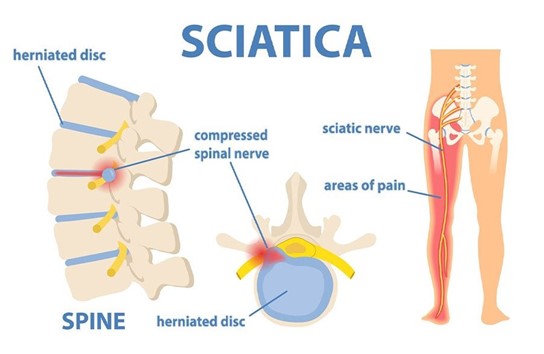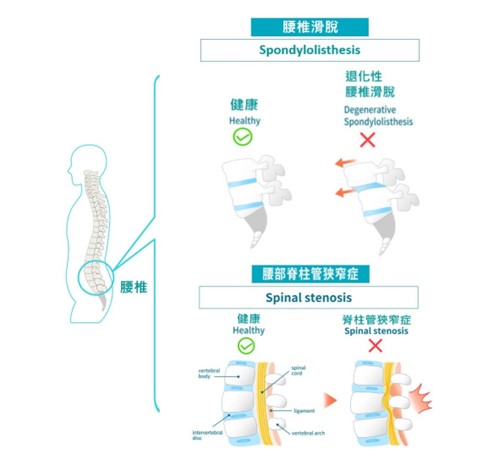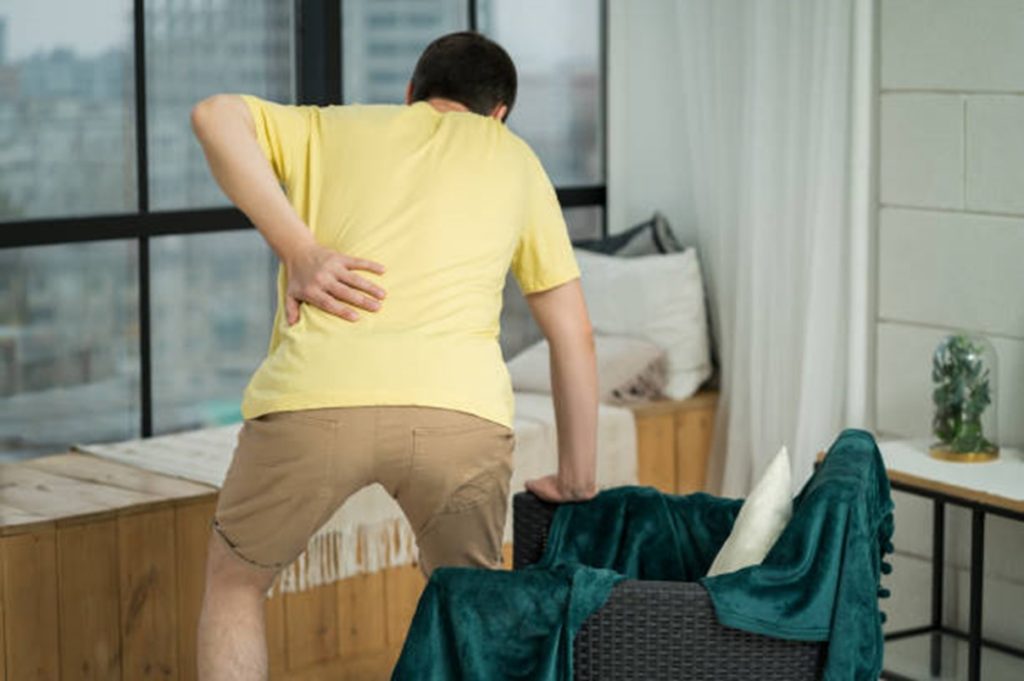Sciatica
Sciatica is a “symptom” caused by compression of the sciatic nerve. It is a name used to describe the symptoms of pain in the lower back and even the legs, but not a disease. Many people think that sciatica is caused by sciatic neuropathy. In fact, nerve root lesions are the most common source of pain. Generally, at the early stage of the disease, you will only occasionally feel short-term pain in the lower limbs. Slowly, the pain will expand and extend from the waist to the buttocks and even the thighs. The pain will also change from intermittent pain to continuous pain.
Sciatica mostly affects the “unilateral” buttocks and legs, and it is rare for patients to suffer from both sides. Different patients may have different degree or feelings of pain, some are mild pain, some are stinging, some are pain with burning sensation, or even extremely uncomfortable that is indescribable. Patients with severe symptoms may also experience paralysis around the anus, resulting in urinary disorders and even incontinence.
Main Symptoms of Sciatica
Sensory Nerve Compression or Inflammation:
- Feeling like a rubber band is being pulled from the lower body to the legs
- Lower back pain
- Pain or numbness in buttocks, legs, or inner thighs, especially when you sit down or crossing your legs while sitting
- Numbness, sting-like or electric shock-like burning sensation extending down the entire leg
- Persistent pain in one hip
- Desensitization to touch in the feet
- In severe cases, the neuralgia intensifies or spreads to: the instep or sole of the foot, and even to other parts of the body such as the groin, vulva, anus, etc.
The pressure on nerves increases especially when the patient stands, walks, sits for a long time, coughs, sneezes, lifts heavy objects, or even exerts force to urinate or laugh, causing the pain more severe and symptoms aggravate.
Motor Nerve Compression:
- Paralysis and weakness of leg muscles, affecting walking
- Sudden rapid onset of pain and inability to stand up
- Difficult to walk and sit down due to the pain
- Unable to bend forward when pain and numbness worsen
Signs of Compression of Autonomic Nerve (affected organs includes bladder, anus, and sexual organs):
- Frequent urination during the day and/or night
- Weakness in defecation, and/or constipation
- In more severe cases, there may even be occasional signs of incontinence
- Signs of decline in sexual function and/or sexual needs
Common Causes of Sciatica
There is a pile of bone and cartilage near the spine, which originally protects the nerve. However, if there are any changes in the bone or cartilage, the nerve may be compressed. Therefore, the common causes of sciatica are mostly related to pain caused by spinal disease, damage, inflammation, nerve root compression or spinal cord stenosis.
Disc Herniation:
“Disc Herniation” is the most common cause of sciatica. A ruptured and herniated disc can compress the spinal cord in the vertebral foramen, causing compression of the sciatic nerve.
The intervertebral disc is a soft and elastic tissue between the two vertebrae of the human body. It functions like a shock absorber to cushion the shock or pressure experienced by the human body during daily activities. If you exercise strenuously, use excessive force, suffer sudden external injuries, or even be overweight or have inappropriate posture for a long period of time, as well as intervertebral disc degeneration, strain, etc., it may cause the intervertebral disc to age, lose water, reduce the supporting capacity, and cause the fibers around the intervertebral disc to weaken. When the wheel ruptures, the nucleus pulposus (soft gel) in the center is squeezed and protruded. If the protruding soft gel stimulates or compresses nearby nerves, it will cause sciatica and inflammatory symptoms. Intervertebral disc herniation may occur in every intervertebral disc. There is a lot of mobility in the neck and waist, especially the fourth and fifth lumbar vertebrae and the first sacral vertebra, which bear the most stress. Lumbar disc herniation is the most common.
The most common age group is between 30 and 50 years old, especially office workers who are overweight, have incorrect postures, sit for long periods of time, wear stilettos and high-heeled shoes, and need to lift heavy objects, are all high-risk groups.

Spondylolisthesis:
The intervertebral disc serves as the connection between the two vertebrae. If the upper and lower bones cannot be grasped, the spine will be like a landslide, with the upper vertebrae sliding in front of the next vertebrae, causing nerve root compression or pulling.
The causes of lumbar spondylolisthesis can be divided into acquired and congenital spondylolisthesis, while acquired degenerative spondylolisthesis is the most common. It occurs more often in elderly people over 65 years old, with more female patients than male patients. Apart from this, it may also be traumatic spondylolisthesis due to severe injuries, such as fractures and lamina rupture, causing spondylolisthesis. Congenital spondylolisthesis is rare, and these patients are prone to spondylolisthesis due to congenital abnormal lumbar spine structure.
Spinal Neural Foraminal Stenosis:
Due to congenital neural foraminal stenosis, acquired or degenerative (such as bone spur hyperplasia, or pathological ligament hyperplasia caused by spinal instability), lumbar vertebrae, disc bone displacement, spondylolisthesis, the neural foraminal path through which the sciatic nerve passes has changed. narrowed, thus compressing the sciatic nerve.

Bone Spurs:
It often occurs in the cervical and lumbar vertebrae. When the cartilage between the vertebrae gradually loses water and elasticity, the pressure on the joint surface of the spine will increase and bulge in the horizontal direction. Some bone spurs will grow at the edges of the joints, compressing our spinal cord or nerves. When this occurs, it will cause nerve root lesions, causing pain and numbness.
Most people will start to develop bone spurs when they are over 45 years old. Male patients are more common, but symptoms begin to appear after about 65 years old.
Tight Muscles in the Waist or Buttocks:
Muscle tightness may also compress nerves. The most famous one is “Piriformis Syndrome”.
Spinal or Nerve Tumors:
If a tumor develops, it may compress the nerves.
Lumbar Spine Degeneration, Strain or Injury
Sports, falls, traffic accidents, work-related injuries, etc., lead to intervertebral disc damage, or spinal or disc displacement, which puts pressure on nerves.
Inflammation of the Spine or nearby Soft Tissues.
Diabetes:
This is one of the few “non-compressive” causes of sciatica. Since diabetic patients have high blood sugar level, the body’s nerves are long-time exposed to a high-sugar level environment. Sugar can also make the body’s nerves susceptible to disease, causing pain.

The Pathogenesis of Sciatica:
- Sudden, or
- Persistent, or
- Recurrent from time to time (in weeks, months, or years), or
- Symptoms will recur over time (a few days, weeks, or months or years), and the condition may change, spread, or worsen with each recurrence.
For information about sciatica, lower back pain and waist pain relief or treatments, you may continue to browse this website for further details.


